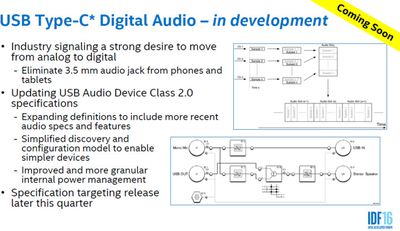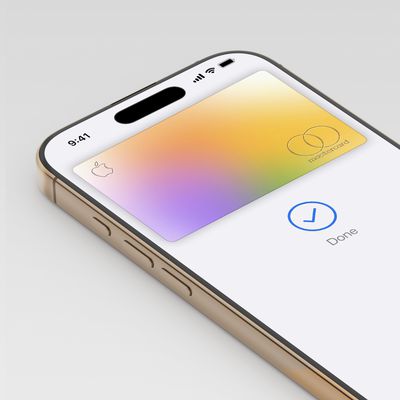Intel this week announced plans to usher in the adoption of an audio USB Type-C connector that would replace the standard 3.5 millimeter analog jack and eventually be capable of digital audio transmission (via Anandtech).
The plans were announced during the Intel Developers Forum (IDF) in Shenzhen, China, where the semiconductor manufacturer set out its project to develop USB Type-C Digital Audio. Intel remained vague about the digital conversion, but set out broad aims to update the USB Audio Device 2.0 protocol specifications to include up-to-date audio features, while simplifying discovery and improving power management, with plans to release the revised specification in the second quarter this year.

Intel hopes that the improved USB-C audio specification would eventually amount to a standardized connector replacement and eliminate the traditional audio jack from laptops, smartphones and tablets, eventually ushering in a transition to fully digital audio.
From a consumer perspective, this could mean higher-quality audio output, more remote control possibilities on headsets, potential biometric health data tracking (such as in-ear heart-rate monitoring), and supplied power for features like active noise-cancelling without the need for dedicated batteries.
The news comes amid iPhone 7 rumors suggesting Apple is also looking to remove the 3.5mm headphone jack on its future mobile devices, however speculation gravitates towards Apple replacing it with a proprietary Lightning port capable of transmitting audio. With no headphone jack, wired headphones would connect to the iPhone 7 using its Lightning port and Bluetooth headphones would connect wirelessly.
Apple could theoretically implement Intel's USB-C digital audio protocol in future Macs, although details remain unknown. Either way, given that LeEco already offers smartphones with USB-C-only audio, and JBL sells noise-cancelling USB-C headphones, the 3.5mm audio jack appears to be nearing the end of its life in the consumer technology market.
























Top Rated Comments
Besides, while I appreciate your point about evolving USB, why do you have faith that Lightning will persist for more than about 2 more iterations of iPhone? Look at it's thickness vs. iPhone now. How many more cuts of "thinner" before it proves too thick to remain THE jack for iDevices? I predict 2 more iterations. Then we'll get the "thinner" Lightning 2 and get to rebuy all this again.
Good point but don't forget it doesn't actually move the DAC out to the headphones, it creates a redundancy of a second DAC. iPhones will still have to have a DAC inside to work as a phone without headphones/earbuds. There's no way around that if an iPhone is going to continue to be a phone. So what this is doing is just duplicating that bit of hardware, shifting when a digital audio signal becomes an analog signal we can actually hear by as little as a few inches further down the pipe (toward the headphone speakers).
I still think the better overall option would be to stick with a universal, ubiquitous standard with virtually nill licensing fees (if any???) instead of embracing a proprietary one owned & controlled by a single company that we all know won't cut the licensing fees low enough to give it any chance to become THE standard on every other kind of device to which one might also want to connect their headphones. So now we get iPhones with "tails" (adapters) and will need to carry around adapters (and yes, that's plural) if we want to use one set of headphones with the various kinds of jacks that will now be in play. Or we can carry around multiple sets of headphones. Either way, we carry around more accessories. For what gain?
Think about the business trip and carry along only one set of headphones:
* Client wants you to plug into their equipment for the conf call. Not lightning, probably 3.5mm.
* Want to jack in to listen to the airplane's audio while the movie plays. Not lightning, probably 3.5mm
* Need to listen to something on your own Mac? Not lightning, probably 3.5mm or maybe USB.
* Step forward a little bit when this push for USB-C with other hardware takes hold. Hook into that. Not lightning, USB3C.
Adapters, adapters, adapters... even to share headphones between your new iPhone and the Macs you already own.
If the argument is for better quality audio, the 3.5mm jack is NOT the problem. Build a better quality DAC inside the iPhone. Analog is analog. Moving the DAC an inch or three further along the pipe is not going to make any difference we can hear... unless a better quality DAC is doing the conversion and then some of us MIGHT be able to hear some difference. However, the phone will still have to have a DAC inside it too. It's not the couple of inches that would make the difference in quality, it's the quality of the DAC.
The Bluetooth alternative argument seems weak to me too. Even if one can set aside the obvious tradeoff in audio quality for the convenience of wireless, again, take the Bluetooth headphone on the business trip. How to wirelessly jack into the airplane's audio to hear the movie? Can you count on every client having a bluetooth setup and willingness to connect you so you can participate in the conf call? Etc.
So again, adapters, adapters, adapters. Or maybe multiple kinds of headphones to lug along. For what exactly that can't be covered much more ubiquitously with a perfectly fine, perfectly functional, everywhere option paired with a better-quality DAC inside the next iPhone?
This is not about replacing "old, outdated" analog with "new, "the future" digital. Audio must be converted to analog for us to hear it. Based on how some of us are trying to rationalize this, perhaps Apple should bottle Water as a product- replace the old, outdated standard of H2O now with Apple's newer, proprietary, somehow "thinner" H2O proprietary blend... a far superior incarnation of water because it's newer... and Apple says so. ;)
The headphone jack isn't going to be dropped for anything better. Just more annoying.